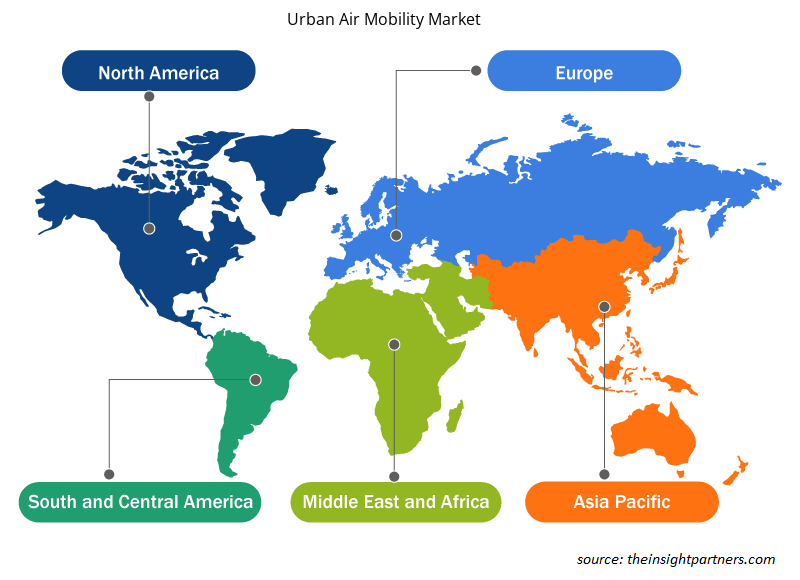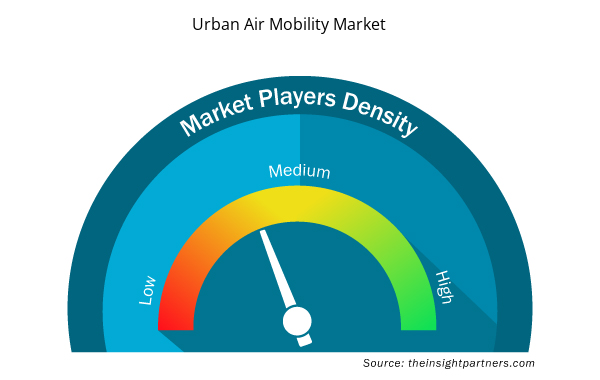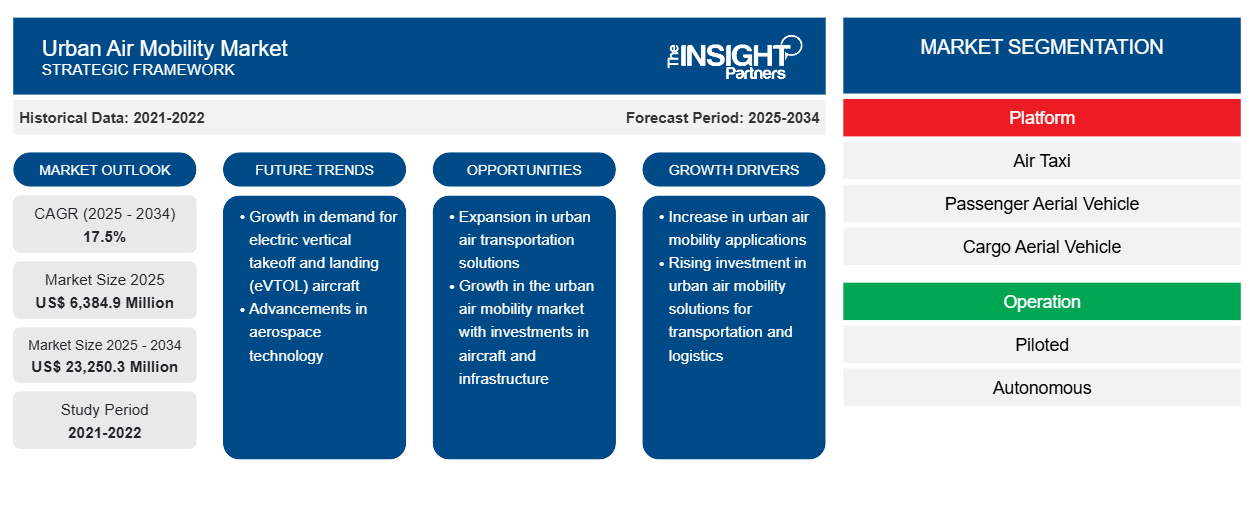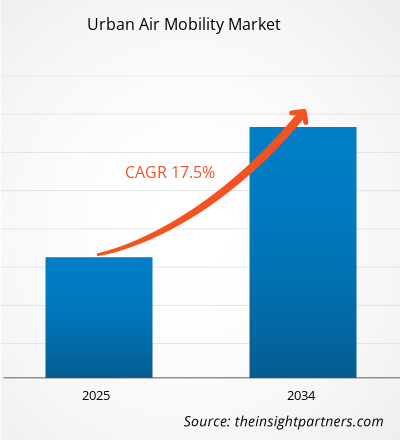من المتوقع أن تبلغ قيمة سوق التنقل الجوي الحضري 6،384.9 مليون دولار أمريكي في عام 2025 ومن المتوقع أن تصل إلى 23،250.3 مليون دولار أمريكي بحلول عام 2034. ومن المتوقع أن ينمو سوق التنقل الجوي الحضري بمعدل نمو سنوي مركب قدره 17.5٪ خلال الفترة المتوقعة من 2025 إلى 2034.
يمكن أن يسافر ما لا يقل عن ثلاثة ركاب ولا يزيد عن خمسة إلى ستة ركاب بواسطة شركات نقل الركاب الجوية الحضرية. في المناطق الريفية، يسافر أكثر من ستة ركاب بواسطة شركات نقل الركاب ذات الثلاث عجلات حسب المتطلبات. تعد زيادة الازدحام المروري في المدن الحضرية عاملاً رئيسيًا في دفع نمو السوق. مع نمو عدد سكان المناطق الحضرية في العالم، كان الازدحام المروري يؤثر بشكل خطير على جودة حياة الناس ويؤثر سلبًا على النمو الاقتصادي العام. على سبيل المثال، وفقًا لشركة INRIX (شركة تحليل حركة المرور)، يقضي المسافر الأمريكي ما يقرب من 41 ساعة في حركة المرور كل عام خلال أوقات الذروة. كما ذكرت أن الازدحام المروري كلف السائقين الأمريكيين ما يقرب من 305 مليار دولار أمريكي في عام 2017، مما يعني متوسط 1445 دولارًا أمريكيًا لكل سائق. علاوة على ذلك، قدرت وكالة حماية البيئة الأمريكية أن متوسط سيارة الركاب تنبعث منها 4.7 طن متري من ثاني أكسيد الكربون كل عام. علاوة على ذلك، ارتفعت حوادث السيارات، جنبًا إلى جنب مع زيادة ملكية المركبات في البلدان النامية مثل الهند والصين. وفقًا لمنظمة الصحة العالمية، يُقتل نحو 1.25 مليون شخص في حوادث السيارات كل عام، أي ما يعادل نحو 3400 حالة وفاة يوميًا. ولا يأخذ هذا في الاعتبار ملايين الإصابات الناجمة عن حوادث غير مميتة.
ينقسم سوق النقل الجوي الحضري العالمي حسب النوع إلى ناقلات الركاب وناقلات البضائع. بناءً على نوع الوقود، ينقسم سوق النقل الجوي الحضري إلى ديزل وبنزين وCNG وLPG وكهرباء. وقد أدى الطلب المتزايد على النقل الجوي الحضري الكهربائي، وزيادة عدد السكان، والحاجة المتزايدة إلى مركبة تساعد في الازدحام المروري في المنطقة إلى تعزيز نمو سوق النقل الجوي الحضري العالمي.
قم بتخصيص هذا التقرير ليناسب متطلباتك
ستحصل على تخصيص لأي تقرير - مجانًا - بما في ذلك أجزاء من هذا التقرير، أو تحليل على مستوى الدولة، وحزمة بيانات Excel، بالإضافة إلى الاستفادة من العروض والخصومات الرائعة للشركات الناشئة والجامعات
- احصل على أهم اتجاهات السوق الرئيسية لهذا التقرير.ستتضمن هذه العينة المجانية تحليلاً للبيانات، بدءًا من اتجاهات السوق وحتى التقديرات والتوقعات.
رؤى حول سوق التنقل الجوي الحضري
التطورات في تكنولوجيا الطيران والقيادة الذاتية
إن التقدم في تكنولوجيات الطيران يخلق الإمكانات لتوفير وسائل نقل مريحة وفعالة عند الطلب للأشخاص والبضائع في المناطق الحضرية. إن التنقل الجوي الحضري (UAM) هو مفهوم نقل لديه القدرة على إعادة بناء التنقل المجتمعي. إنه يقترح النقل الجوي الحضري بأسعار معقولة للغاية ويمكن الوصول إليه وسريع، مما من شأنه أن يقلل من الازدحام الأرضي من خلال تفريغ البنية التحتية للنقل على الطرق الحالية. يعتمد UAM على المكاسب في التقنيات مثل الدفع الكهربائي الموزع، ونماذج الأعمال الجديدة مثل مشاركة الركوب القائمة على التطبيقات، والاتجاهات في تصنيع الفضاء المتقدم التي من شأنها أن تقلل من تكاليف الإنتاج. سيكون زيادة ائتمان أتمتة المركبات وعمليات المركبات ذاتية القيادة أمرًا بالغ الأهمية في تحقيق رؤية UAM المستقلة. ستكون هناك حاجة إلى الاستقلال لنظام نقل قابل للتطبيق اقتصاديًا وقادر على دعم الطلب المتوقع المرتفع. الزيادات الكبيرة في النضج التكنولوجي للمركبات المستقرة والقابلة للمناورة والإقلاع والهبوط العمودي (VTOL)، والطيران الآلي للغاية من شأنها أن تدفع صناعة UAM في المقام الأول.
رؤى السوق القائمة على المنصة
ينقسم سوق التنقل الجوي الحضري على أساس المنصة إلى سيارات أجرة جوية، ومركبة جوية للركاب، ومركبة جوية للشحن، وسيارة إسعاف جوية. هناك مجموعة واسعة من التطبيقات لـ UAM التي تسهل النقل السهل والسريع للبضائع وكذلك البشر. تُستخدم هذه UAMs على نطاق واسع لنقل العناصر الصغيرة والمنتجات الطبية، وتحمل الركاب أيضًا. ومع ذلك، فإن حلول التنقل هذه لها حدود طيران خاصة بها اعتمادًا على استخدامها. لا يُسمح لمركبات UAM بالتحليق على مدى منخفض حيث ستصطدم بالمباني المتوسطة الحجم والشاهقة ولا على مدى مرتفع لضرب أي خطوط جوية.
رؤى السوق القائمة على العمليات
ينقسم سوق التنقل الجوي الحضري على أساس التشغيل إلى طائرات مسيرة وطائرات ذاتية القيادة. ومن المتوقع أن يقود قطاع الطائرات ذاتية القيادة السوق خلال فترة التوقعات، حيث أن الطائرات العمودية الكهربائية ذاتية القيادة أكثر ملاءمة لنقل البضائع والركاب ومن المتوقع استخدامها بشكل متزايد في النقل بين المدن.
يركز اللاعبون العاملون في سوق التنقل الجوي الحضري على الاستراتيجيات، مثل مبادرات السوق، والاستحواذات، وإطلاق المنتجات، للحفاظ على مواقعهم في سوق التنقل الجوي الحضري. فيما يلي بعض التطورات التي قام بها اللاعبون الرئيسيون في سوق التنقل الجوي الحضري:
في فبراير 2020، وقعت شركة إيرباص وهيئة الطيران المدني في سنغافورة مذكرة تفاهم لتمكين التنقل الجوي الحضري في سنغافورة. ومن شأن هذا التعاون تمكين التنقل الجوي الحضري في البلاد.
في فبراير 2019، دخلت شركة Airspace Experience Technologies في اتفاقية نهائية مع شركة Spirit AeroSystems لإنشاء طائرة إقلاع وهبوط عمودي معتمدة بالكامل كهربائية (eVTOL).
رؤى إقليمية حول سوق النقل الجوي الحضري
لقد قام المحللون في Insight Partners بشرح الاتجاهات والعوامل الإقليمية المؤثرة على سوق التنقل الجوي الحضري طوال فترة التوقعات بشكل شامل. يناقش هذا القسم أيضًا قطاعات سوق التنقل الجوي الحضري والجغرافيا في جميع أنحاء أمريكا الشمالية وأوروبا ومنطقة آسيا والمحيط الهادئ والشرق الأوسط وأفريقيا وأمريكا الجنوبية والوسطى.

- احصل على البيانات الإقليمية المحددة لسوق التنقل الجوي الحضري
نطاق تقرير سوق التنقل الجوي الحضري
| سمة التقرير | تفاصيل |
|---|---|
| حجم السوق في عام 2025 | 6,384.9 مليون دولار أمريكي |
| حجم السوق بحلول عام 2034 | 23,250.3 مليون دولار أمريكي |
| معدل النمو السنوي المركب العالمي (2025 - 2034) | 17.5% |
| البيانات التاريخية | 2021-2022 |
| فترة التنبؤ | 2025-2034 |
| القطاعات المغطاة | حسب المنصة
|
| المناطق والدول المغطاة | أمريكا الشمالية
|
| قادة السوق وملفات تعريف الشركات الرئيسية |
|
كثافة اللاعبين في سوق النقل الجوي الحضري: فهم تأثيرها على ديناميكيات الأعمال
يشهد سوق التنقل الجوي الحضري نموًا سريعًا، مدفوعًا بالطلب المتزايد من المستخدم النهائي بسبب عوامل مثل تفضيلات المستهلكين المتطورة والتقدم التكنولوجي والوعي المتزايد بفوائد المنتج. ومع ارتفاع الطلب، تعمل الشركات على توسيع عروضها والابتكار لتلبية احتياجات المستهلكين والاستفادة من الاتجاهات الناشئة، مما يؤدي إلى زيادة نمو السوق.
تشير كثافة اللاعبين في السوق إلى توزيع الشركات أو المؤسسات العاملة في سوق أو صناعة معينة. وهي تشير إلى عدد المنافسين (اللاعبين في السوق) الموجودين في مساحة سوق معينة نسبة إلى حجمها أو قيمتها السوقية الإجمالية.
الشركات الرئيسية العاملة في سوق التنقل الجوي الحضري هي:
- إيرباص ساس
- علوم الطيران أورورا
- تكنولوجيات تجربة الطيران الجوي
- شركة بيل تيكسترون
- شركة إي هانج للتكنولوجيا الذكية المحدودة
إخلاء المسؤولية : الشركات المذكورة أعلاه ليست مرتبة بأي ترتيب معين.

- احصل على نظرة عامة على أهم اللاعبين الرئيسيين في سوق التنقل الجوي الحضري
سوق التنقل الجوي الحضري – حسب المنصة
- تاكسي جوي
- مركبة جوية للركاب
- مركبة جوية لنقل البضائع
- الإسعاف الجوي
سوق التنقل الجوي الحضري – حسب العملية
- مُوجه
- مستقل
سوق النقل الجوي الحضري – حسب المنطقة الجغرافية
أمريكا الشمالية
- نحن
- كندا
أوروبا
- فرنسا
- ألمانيا
- المملكة المتحدة
- روسيا
- بقية أوروبا
بقية العالم
سوق النقل الجوي الحضري – نبذة عن الشركة
- إيرباص ساس
- علوم الطيران أورورا
- مروحية بيل تيكسترون المحدودة
- ايهانج
- إمبراير إكس
- شركة هونيويل الدولية
- كيتي هوك
- شركة موغ
- شركة فولوكوبتر المحدودة
- التحليل التاريخي (سنتان)، السنة الأساسية، التوقعات (7 سنوات) مع معدل النمو السنوي المركب
- تحليل PEST و SWOT
- حجم السوق والقيمة / الحجم - عالميًا وإقليميًا وقطريًا
- الصناعة والمنافسة
- مجموعة بيانات Excel



Report Coverage
Revenue forecast, Company Analysis, Industry landscape, Growth factors, and Trends

Segment Covered
This text is related
to segments covered.

Regional Scope
North America, Europe, Asia Pacific, Middle East & Africa, South & Central America

Country Scope
This text is related
to country scope.
الأسئلة الشائعة
Air Taxi segment led the urban air mobility market. The air taxi usage case is a door-to-door (or near-ubiquitous) ridesharing operation, which permits customers to call vertical takeoff and landing aircraft (VTOLs) to their preferred pickup locations and stipulate drop-off destinations at rooftops across the given city. These rides are on-demand and unscheduled, just like ridesharing applications the customers use in the present scenario. Similar to the air metro case, the aerial vehicles are both autonomous as well as operated by the pilots and can accommodate 2 to 5 passengers simultaneously, by an average load of 1 passenger per trip.
Advances in aviation technologies are creating the potential to provide convenient and efficient on-demand transportation for people and cargo in metropolitan areas. Urban Air Mobility (UAM) is a transportation concept that has the potential to reconstruct societal mobility. It proposes highly affordable, accessible, and fast urban air transit, which would reduce ground-based congestion by off-loading the existing roadways transportation infrastructure. Therefore, the technological advancements in the aviation industry and increasing traffic congestion are the major factors driving the growth of urban air mobility market.
The North America region will lead the Urban air mobility market in 2025 owing to the supportive government initiatives and an increasing number of companies spending rigorously on the development of urban air mobility products.
Trends and growth analysis reports related to Aerospace and Defense : READ MORE..
The List of Companies - Urban Air Mobility (UAM) Market
- Airbus SAS
- Aurora Flight Sciences
- Airspace Experience Technologies, Inc.
- Bell Textron Inc
- EHang Intelligent Technology Co. Ltd
- EmbraerX
- Jaunt Air Mobility LLC
- Kitty Hawk
- Moog Inc.
- Volocopter GmbH
The Insight Partners performs research in 4 major stages: Data Collection & Secondary Research, Primary Research, Data Analysis and Data Triangulation & Final Review.
- Data Collection and Secondary Research:
As a market research and consulting firm operating from a decade, we have published and advised several client across the globe. First step for any study will start with an assessment of currently available data and insights from existing reports. Further, historical and current market information is collected from Investor Presentations, Annual Reports, SEC Filings, etc., and other information related to company’s performance and market positioning are gathered from Paid Databases (Factiva, Hoovers, and Reuters) and various other publications available in public domain.
Several associations trade associates, technical forums, institutes, societies and organization are accessed to gain technical as well as market related insights through their publications such as research papers, blogs and press releases related to the studies are referred to get cues about the market. Further, white papers, journals, magazines, and other news articles published in last 3 years are scrutinized and analyzed to understand the current market trends.
- Primary Research:
The primarily interview analysis comprise of data obtained from industry participants interview and answers to survey questions gathered by in-house primary team.
For primary research, interviews are conducted with industry experts/CEOs/Marketing Managers/VPs/Subject Matter Experts from both demand and supply side to get a 360-degree view of the market. The primary team conducts several interviews based on the complexity of the markets to understand the various market trends and dynamics which makes research more credible and precise.
A typical research interview fulfils the following functions:
- Provides first-hand information on the market size, market trends, growth trends, competitive landscape, and outlook
- Validates and strengthens in-house secondary research findings
- Develops the analysis team’s expertise and market understanding
Primary research involves email interactions and telephone interviews for each market, category, segment, and sub-segment across geographies. The participants who typically take part in such a process include, but are not limited to:
- Industry participants: VPs, business development managers, market intelligence managers and national sales managers
- Outside experts: Valuation experts, research analysts and key opinion leaders specializing in the electronics and semiconductor industry.
Below is the breakup of our primary respondents by company, designation, and region:

Once we receive the confirmation from primary research sources or primary respondents, we finalize the base year market estimation and forecast the data as per the macroeconomic and microeconomic factors assessed during data collection.
- Data Analysis:
Once data is validated through both secondary as well as primary respondents, we finalize the market estimations by hypothesis formulation and factor analysis at regional and country level.
- Macro-Economic Factor Analysis:
We analyse macroeconomic indicators such the gross domestic product (GDP), increase in the demand for goods and services across industries, technological advancement, regional economic growth, governmental policies, the influence of COVID-19, PEST analysis, and other aspects. This analysis aids in setting benchmarks for various nations/regions and approximating market splits. Additionally, the general trend of the aforementioned components aid in determining the market's development possibilities.
- Country Level Data:
Various factors that are especially aligned to the country are taken into account to determine the market size for a certain area and country, including the presence of vendors, such as headquarters and offices, the country's GDP, demand patterns, and industry growth. To comprehend the market dynamics for the nation, a number of growth variables, inhibitors, application areas, and current market trends are researched. The aforementioned elements aid in determining the country's overall market's growth potential.
- Company Profile:
The “Table of Contents” is formulated by listing and analyzing more than 25 - 30 companies operating in the market ecosystem across geographies. However, we profile only 10 companies as a standard practice in our syndicate reports. These 10 companies comprise leading, emerging, and regional players. Nonetheless, our analysis is not restricted to the 10 listed companies, we also analyze other companies present in the market to develop a holistic view and understand the prevailing trends. The “Company Profiles” section in the report covers key facts, business description, products & services, financial information, SWOT analysis, and key developments. The financial information presented is extracted from the annual reports and official documents of the publicly listed companies. Upon collecting the information for the sections of respective companies, we verify them via various primary sources and then compile the data in respective company profiles. The company level information helps us in deriving the base number as well as in forecasting the market size.
- Developing Base Number:
Aggregation of sales statistics (2020-2022) and macro-economic factor, and other secondary and primary research insights are utilized to arrive at base number and related market shares for 2022. The data gaps are identified in this step and relevant market data is analyzed, collected from paid primary interviews or databases. On finalizing the base year market size, forecasts are developed on the basis of macro-economic, industry and market growth factors and company level analysis.
- Data Triangulation and Final Review:
The market findings and base year market size calculations are validated from supply as well as demand side. Demand side validations are based on macro-economic factor analysis and benchmarks for respective regions and countries. In case of supply side validations, revenues of major companies are estimated (in case not available) based on industry benchmark, approximate number of employees, product portfolio, and primary interviews revenues are gathered. Further revenue from target product/service segment is assessed to avoid overshooting of market statistics. In case of heavy deviations between supply and demand side values, all thes steps are repeated to achieve synchronization.
We follow an iterative model, wherein we share our research findings with Subject Matter Experts (SME’s) and Key Opinion Leaders (KOLs) until consensus view of the market is not formulated – this model negates any drastic deviation in the opinions of experts. Only validated and universally acceptable research findings are quoted in our reports.
We have important check points that we use to validate our research findings – which we call – data triangulation, where we validate the information, we generate from secondary sources with primary interviews and then we re-validate with our internal data bases and Subject matter experts. This comprehensive model enables us to deliver high quality, reliable data in shortest possible time.


 احصل على عينة مجانية لهذا التقرير
احصل على عينة مجانية لهذا التقرير